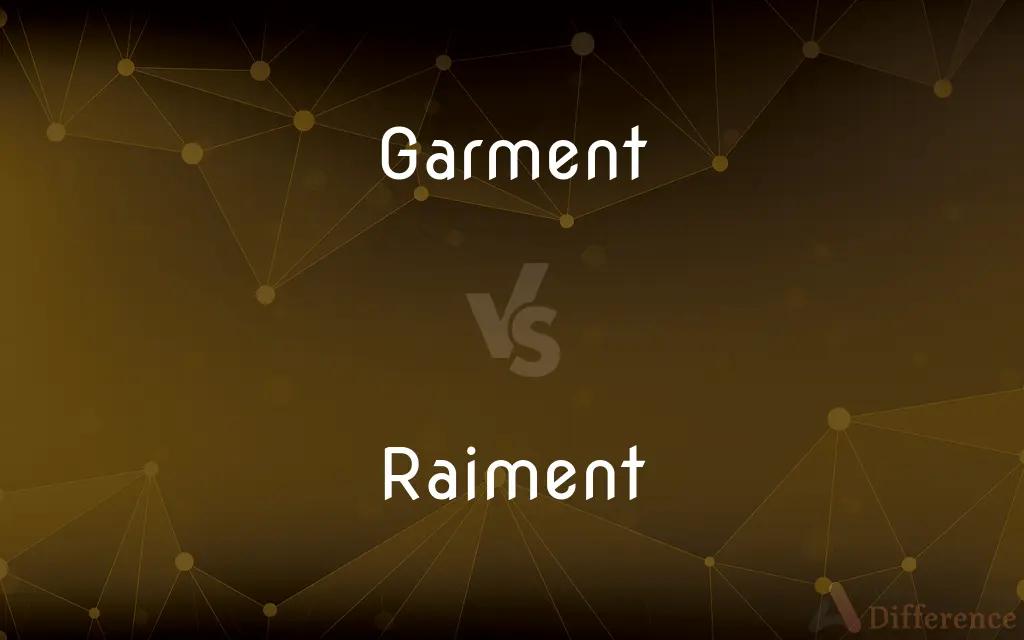Garment vs. Raiment — What's the Difference?
By Maham Liaqat & Fiza Rafique — Updated on April 1, 2024
Garment refers to any piece of clothing, while raiment is an archaic term for clothing, often implying a more formal or elaborate style.

Difference Between Garment and Raiment
Table of Contents
ADVERTISEMENT
Key Differences
A garment is a generic term for any item of clothing, ranging from everyday wear like shirts and pants to specialized attire such as gowns and uniforms. It is a broad category that encompasses all types of clothing pieces. On the other hand, raiment, though essentially synonymous with clothing, carries an old-fashioned tone and is rarely used in everyday language. It often suggests clothing of a particular quality or style, sometimes implying more formal or elaborate attire.
When discussing the manufacturing industry, the term garment is frequently used to refer to the mass production of clothing items. It is common in the fashion and apparel industry, signifying a modern context of clothing production and retail. Conversely, raiment is not typically used in modern commercial or industrial contexts, reflecting its status as an archaic term with no specific implications for fashion or production processes.
In literature, "garment" is used in a straightforward manner to denote clothing, without any inherent stylistic or qualitative implications. Raiment, however, when used, often adds a layer of richness or antiquity to the text, evoking a sense of historical or classical eras. This usage highlights the stylistic difference between the terms, with raiment bringing a literary or poetic flavor to descriptions.
Legal and regulatory texts dealing with clothing standards, safety, and commerce usually prefer the term garment. This preference underscores the term's relevance to contemporary discussions about clothing, including aspects like trade, labeling, and environmental regulations. Raiment, given its archaic and less precise nature, is not suited to such contexts where clarity and specificity are paramount.
Cultural references to clothing often employ the term garment to discuss traditional or ceremonial attire across different societies, emphasizing the variety and significance of clothing in cultural practices. In contrast, raiment, though it could theoretically be applied in such discussions, is less likely to be used due to its outdated feel and the specific connotations it might carry regarding style or formality.
ADVERTISEMENT
Comparison Chart
Definition
Any item of clothing.
An archaic term for clothing, often with formal implications.
Usage Context
Modern, covers all types of clothing.
Archaic, rarely used in contemporary language.
Industry Relevance
Common in fashion and apparel industry.
Not used in modern commercial contexts.
Literary Connotation
Neutral, straightforward reference to clothing.
Implies richness, antiquity, or formality.
Legal and Regulatory Use
Preferred for clarity and specificity.
Not suitable due to its archaic nature and lack of precision.
Compare with Definitions
Garment
Any article of clothing, regardless of style or purpose.
The designer showcased a range of garments in her latest collection.
Raiment
Rarely used in everyday conversation, bearing a literary or poetic tone.
The novel described the peasants in humble raiment.
Garment
Used to describe items in fashion and apparel.
The garment industry is a major global economic player.
Raiment
Not common in modern legal or industrial discussions.
Raiment is a term more fitting for historical novels than fashion textbooks.
Garment
Often mentioned in technical or industry-specific contexts.
Garment sizing varies significantly across brands.
Raiment
An outdated term for clothing, usually implying something special or formal.
The king appeared in his finest raiment.
Garment
Can refer to both everyday and special-occasion clothing.
He wore his best garment to the wedding.
Raiment
Suggests a historical or traditional context.
The museum displayed the raiment of 18th-century nobility.
Garment
Includes both outerwear and underwear.
Thermal garments are essential for winter sports.
Raiment
Implies a certain level of elaborateness or decorativeness.
The portrait featured a woman in elaborate raiment.
Garment
An article of clothing.
Raiment
Clothing; garments.
Garment
To clothe; dress.
Raiment
Clothing, garments, dress, material.
Garment
A single item of clothing.
Raiment
Clothing in general; vesture; garments; - usually singular in form, with a collective sense.
Living, both food and raiment she supplies.
Garment
(figurative) The visible exterior in which a thing is invested or embodied.
Raiment
An article of dress.
Garment
(Mormonism) temple garment
Raiment
Especially fine or decorative clothing
Garment
(transitive) To clothe in a garment.
Raiment
Provide with clothes or put clothes on;
Parents must feed and dress their child
Garment
Any article of clothing, as a coat, a gown, etc.
No man putteth a piece of new cloth unto old garment.
Garment
An article of clothing;
Garments of the finest silk
Garment
Provide with clothes or put clothes on;
Parents must feed and dress their child
Common Curiosities
Is there a difference between garments and apparel?
The terms are largely interchangeable, though "garment" can also specifically refer to individual pieces of clothing.
Can the term garment refer to both modern and traditional clothing?
Yes, it applies to all types of clothing, regardless of the era or cultural background.
How is the term garment used in industry?
It's widely used in the fashion and apparel industry to refer to clothing items, from production to retail.
Can raiment be used in modern writing?
It can be used for stylistic purposes in literature or poetry to evoke a sense of antiquity or formality.
Are garments only for everyday use?
No, garments can be for everyday wear, special occasions, or specific functions like sports or safety.
Does raiment imply a certain type of clothing?
While not strictly defined, raiment often suggests more formal, elaborate, or historical clothing.
Is raiment ever used in legal or commercial contexts today?
Rarely, if ever, due to its archaic nature and the preference for more precise, modern terminology.
What defines a garment?
A garment is any item of clothing, encompassing a wide range of styles and purposes.
Why is raiment considered an archaic term?
Raiment is deemed archaic due to its rare usage in contemporary language, retaining a historical or formal tone.
How does the use of raiment differ from garment in literature?
Raiment is used to add a layer of richness, formality, or historical context, unlike the neutral term garment.
Share Your Discovery

Previous Comparison
Granodiorite vs. Granite
Next Comparison
Mad vs. SadAuthor Spotlight
Written by
Maham LiaqatCo-written by
Fiza RafiqueFiza Rafique is a skilled content writer at AskDifference.com, where she meticulously refines and enhances written pieces. Drawing from her vast editorial expertise, Fiza ensures clarity, accuracy, and precision in every article. Passionate about language, she continually seeks to elevate the quality of content for readers worldwide.
















































